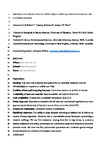Individual and collective behaviour of fish subject to differing risk-level treatments with a sympatric predator
| dc.contributor.author | Wilson, ADM | |
| dc.contributor.author | Schaerf, TM | |
| dc.contributor.author | Ward, AJW | |
| dc.date.accessioned | 2022-12-16T12:44:21Z | |
| dc.date.available | 2022-12-16T12:44:21Z | |
| dc.date.issued | 2022-12 | |
| dc.identifier.issn | 0340-5443 | |
| dc.identifier.issn | 1432-0762 | |
| dc.identifier.other | 160 | |
| dc.identifier.uri | http://hdl.handle.net/10026.1/20083 | |
| dc.description.abstract |
The ability to adapt behaviour according to context is vital to the success of many organisms, particularly when it comes to mitigating risk, across time and space, in unpredictable environments. While many studies have examined the role of predation threat in shaping behaviour, very few have quantitatively investigated prey responses across different elements of perceived risk or ecological contexts. Here, we present a detailed analysis of how mosquitofish (Gambusia holbrooki) adapt their individual and collective behaviour in five experimental treatments designed to replicate different core elements of predator threat. As risk increased, within and across treatments, fish decreased movements across key regions of their environment, swimming speed and nearest neighbour distances, reflecting a threat-sensitive approach. Furthermore, movement predictability also decreased when fish occupied higher risk areas. Within and between treatments, increased risk shaped the local interactions among fish. Local density, group polarisation, and alignment of near neighbours increased, while patterns of local density differed according to whether the fish were in a preferred (region of low perceived risk) or non-preferred (region of high perceived risk) area. Groups in non-preferred areas became elongated, suggesting more rapid locomotion. The rate of turning response and changes in speed relative to the positions of near neighbours increased as a function of risk in safer areas but became less coordinated in areas and treatments associated with higher risk. Importantly, the interactions between fish under the greatest risk also showed a novel qualitative shift in patterns, with fish prioritising group cohesion over group order. Taken together, these results demonstrate the considerable flexibility of fish to adapt according to risk, producing both quantitative and qualitative changes in behaviour as a function of proximate threat levels. | |
| dc.format.extent | 160- | |
| dc.language | en | |
| dc.language.iso | en | |
| dc.publisher | Springer Science and Business Media LLC | |
| dc.rights | Attribution-NonCommercial-NoDerivatives 4.0 International | |
| dc.rights.uri | http://creativecommons.org/licenses/by-nc-nd/4.0/ | |
| dc.subject | Predator-prey | |
| dc.subject | Threat | |
| dc.subject | Behavioural flexibility | |
| dc.subject | Shoaling | |
| dc.subject | Collective movement | |
| dc.title | Individual and collective behaviour of fish subject to differing risk-level treatments with a sympatric predator | |
| dc.type | journal-article | |
| dc.type | Article | |
| plymouth.author-url | https://www.webofscience.com/api/gateway?GWVersion=2&SrcApp=PARTNER_APP&SrcAuth=LinksAMR&KeyUT=WOS:000886205600001&DestLinkType=FullRecord&DestApp=ALL_WOS&UsrCustomerID=11bb513d99f797142bcfeffcc58ea008 | |
| plymouth.issue | 12 | |
| plymouth.volume | 76 | |
| plymouth.publication-status | Published | |
| plymouth.journal | Behavioral Ecology and Sociobiology | |
| dc.identifier.doi | 10.1007/s00265-022-03269-4 | |
| plymouth.organisational-group | /Plymouth | |
| plymouth.organisational-group | /Plymouth/Faculty of Science and Engineering | |
| plymouth.organisational-group | /Plymouth/Faculty of Science and Engineering/School of Biological and Marine Sciences | |
| plymouth.organisational-group | /Plymouth/REF 2021 Researchers by UoA | |
| plymouth.organisational-group | /Plymouth/REF 2021 Researchers by UoA/UoA07 Earth Systems and Environmental Sciences | |
| plymouth.organisational-group | /Plymouth/Users by role | |
| plymouth.organisational-group | /Plymouth/Users by role/Academics | |
| dcterms.dateAccepted | 2022-11-10 | |
| dc.rights.embargodate | 2023-11-21 | |
| dc.identifier.eissn | 1432-0762 | |
| rioxxterms.versionofrecord | 10.1007/s00265-022-03269-4 | |
| rioxxterms.licenseref.uri | http://creativecommons.org/licenses/by-nc-nd/4.0/ | |
| rioxxterms.type | Journal Article/Review |



